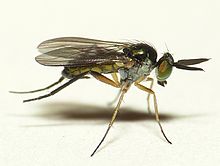Chaetogonopteron is a genus of flies in the family Dolichopodidae.
Cymatopus is a genus of flies in the family Dolichopodidae. Members of the genus are found on rocky coasts of the Indo-West Pacific.

Diaphorus is a genus of flies in the family Dolichopodidae. Lyroneurus was formerly considered a subgenus, but is now either treated as a synonym of Chrysotus or treated as a distinct genus.
Phacaspis is a genus of flies in the family Dolichopodidae. It is known from Southeast Asia, Papua New Guinea and Micronesia. Flies in the genus are small, with metallic green coloring. They are marine, and are commonly found on mudflats in front of mangroves.
Physopyga is a genus of flies in the family Dolichopodidae found in mangroves in Papua New Guinea. It contains a single species, Physopyga miranda.

Rhaphium is a genus of flies in the family Dolichopodidae. It is the largest genus within the subfamily Rhaphiinae, with over 200 species currently known.
Scepastopyga is a genus of flies in the family Dolichopodidae. There is only one described species, Scepastopyga semiflava, which was described from Papua New Guinea by Patrick Grootaert and Henk J. G. Meuffels in 1997. An unidentified species of Scepastopyga was reported from Singapore in 2002, which is thought to show that the genus may be distributed across the Malesian Archipegalo. The fly is small, with a body length of about 2 mm, and is coloured yellow or brown without a metallic gloss.
Scotiomyia is a genus of flies in the family Dolichopodidae. It is distributed in Papua New Guinea, Singapore and China.
Thinolestris is a genus of flies in the family Dolichopodidae. The genus is distributed along coasts of the Western Pacific and Southeast Asia, and members of the genus are found in the intertidal zone. According to Grootaert and Evenhuis (2006), adults are active on beaches with small pebbles mixed with sandy patches.

Thinophilus is a genus of flies in the family Dolichopodidae. It includes about 146 described species distributed worldwide. Most species of the genus are found in coastal habitats, while a few species are found in freshwater habitats.
Urodolichus is a genus of fly in the family Dolichopodidae. It is known from the Afrotropical realm, Indomalayan realm and Australasian realm. It has been placed in either Rhaphiinae or Diaphorinae, though Grichanov & Brooks (2017) consider the genus to be incertae sedis within the family Dolichopodidae.

Hydrophorinae is a subfamily of flies in the family Dolichopodidae. Several molecular phylogenetic analyses of the family have found evidence that the subfamily in its current sense is polyphyletic.

Achalcinae is a subfamily of flies in the family Dolichopodidae. It is an ancestral group close to Medeterinae and Sciapodinae.

Dolichopodinae is a subfamily of flies in the family Dolichopodidae.

Diaphorinae is a subfamily of flies in the family Dolichopodidae.
Cryptophleps is a genus of flies in the family Dolichopodidae.

Peloropeodinae is a subfamily of flies in the family Dolichopodidae. In some classifications, the genera of the subfamily are included in Sympycninae. According to a molecular phylogenetic analysis of the family Dolichopodidae by Germann et al. (2011), the subfamily is polyphyletic.

Sympycninae is a subfamily of flies in the family Dolichopodidae. In some classifications, this subfamily includes the genera of the subfamilies Peloropeodinae and Xanthochlorinae.
Ngirhaphium is a genus of flies in the family Dolichopodidae. It includes six species known from mangroves in Southeast Asia. Ngirhaphium closely resembles the genus Rhaphium and was originally placed in the subfamily Rhaphiinae, though several molecular phylogenetic analyses were unable to resolve its phylogenetic position. The genus is named after Peter Kee Lin Ng, a professor at the National University of Singapore; the genus name combines the family name "Ng" and the generic name Rhaphium.









